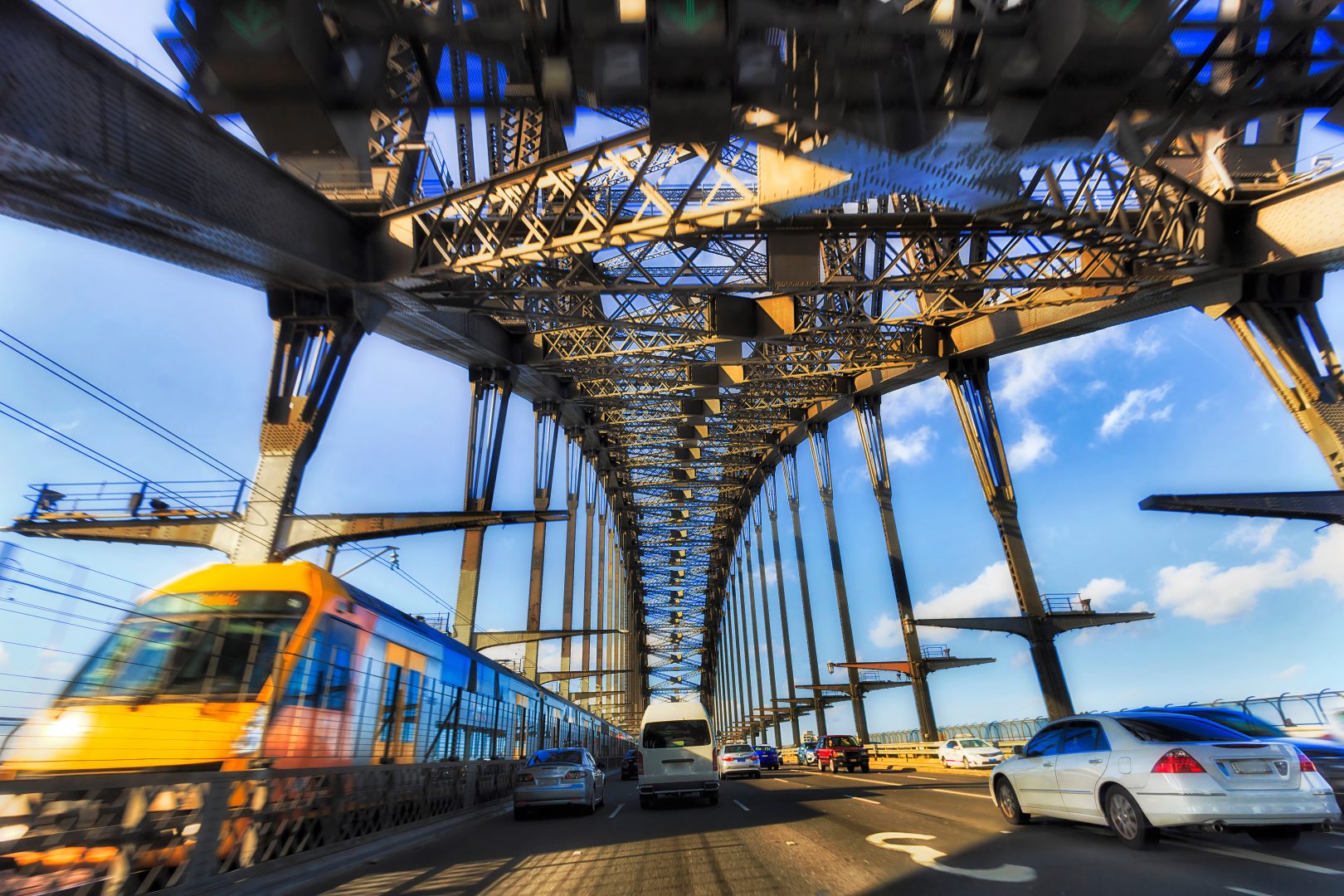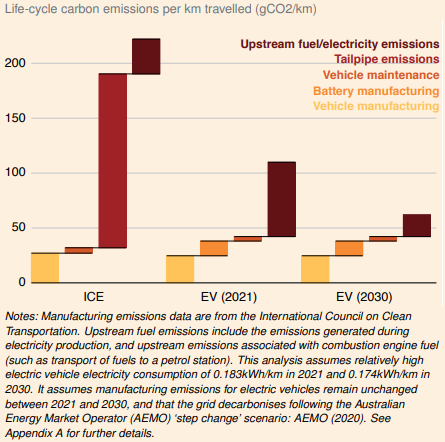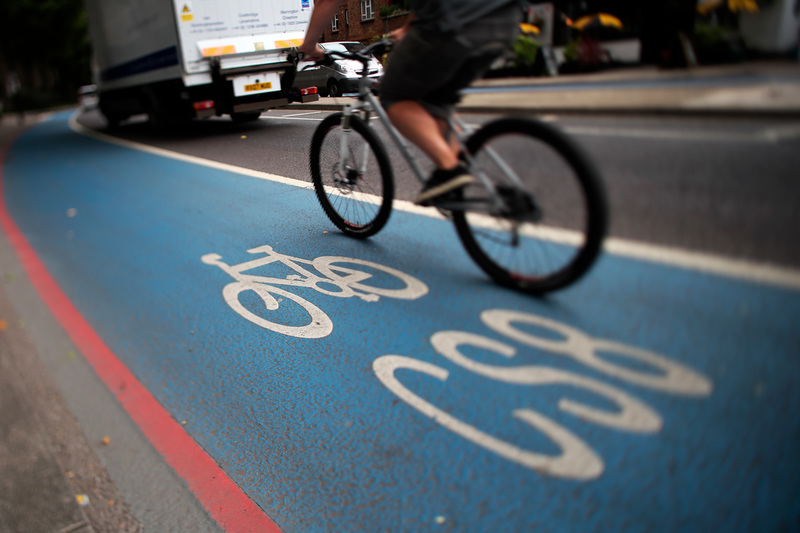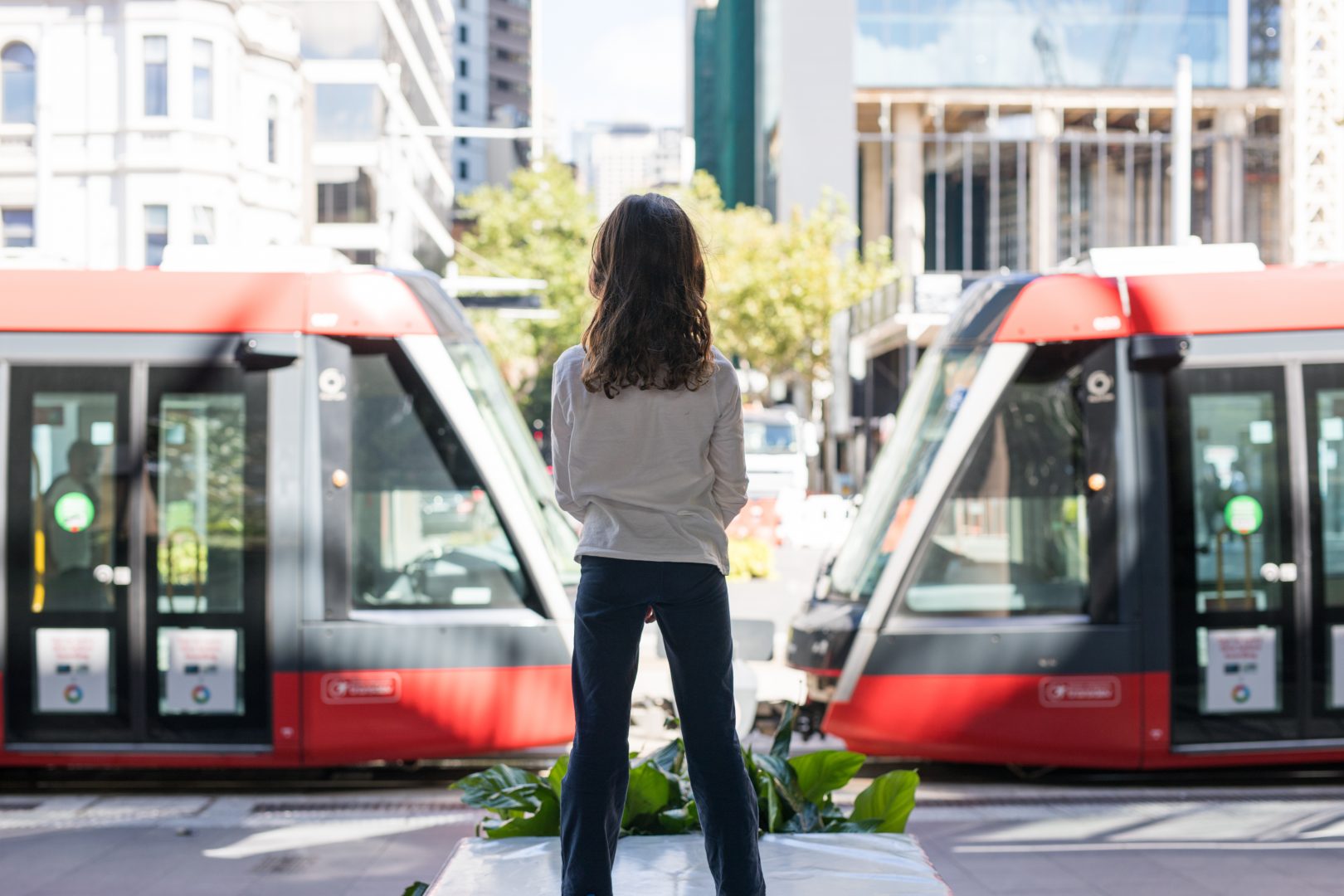Giving Australians the cleaner transport options they want and need
Our transport sector is the 3rd largest source of greenhouse pollution – and it’s growing. How does the transport sector put emissions into reverse and clean up its act?

Radfahrer faehrt auf blau gekennzeichnetem Fahrradweg in Chelsea, London. Photo by Jiri Rezac / Greenpeace||’The Grattan Car Plan’ highlights the disparity in lifecycle emissions between petrol and electric vehicles – and that’s even before the decarbonisation of our grid accelerates. Image from the Grattan Institute.
The average Australian motor vehicle drives around 12,000km a year. Our transport sector emits the 3rd most greenhouse pollution of any sector and, in an era where we need to be cutting emissions, those from our transport are actually rising. There is no single solution to this particular problem, but there are things we can do as a nation that can improve our current situation.
When we break down our transport emissions, we can see that over 60% of them come from cars and light commercial vehicles. This is around 10 times as much as buses and rail combined. If we want to make the changes we need, then we need to look at our vehicles and how we can reduce their emissions significantly.
Electrifying our cars
Australians love their cars, and there are around 21 million vehicles in a country of around 25 million people. Imagine what would happen if we cleaned up the cars on our streets.
Australia currently lags behind when it comes to electric vehicle uptake. Last year only 2% of new vehicle sales were electric, while in the UK it’s 25% and in Norway a whopping 85%.
Even before we consider the decarbonisation of our grid, battery electric vehicles are the cleanest cars on the market. Their emissions are already less than half that of their petrol equivalent.

‘The Grattan Car Plan‘ highlights the disparity in lifecycle emissions between petrol and electric vehicles – and that’s even before the decarbonisation of our grid accelerates. Image from the Grattan Institute.
As we power more of our lives with renewable energy sources like solar and wind the environmental case for electric vehicles becomes completely undeniable.
That’s why we are campaigning for policies that will stimulate the electric vehicle market here in Australia. Electric vehicles won’t just benefit their owners, but everyone in the community. For every additional electric vehicle on our road we are removing large amounts of greenhouse gas emissions from our environment. It’s dirty air none of us should have to breathe.
[divider style=”single” border=”small” color=”#cccccc”] Let the Climate Change and Energy Minister Chris Bowen know that Australia needs a strong fuel efficiency standard:
[button href=”https://act.greenpeace.org.au/electrify-fes-petition” style=”emboss” size=”medium” color=”#6aca25″ hovercolor=”#000000″ textcolor=”#000000″ texthovercolor=”#ffffff”]Sign our Petition[/button]
[divider style=”single” border=”small” color=”#999999″]
Do we just need to change the car we drive?
While switching to an electric vehicle will make a big difference, it needs to be part of something bigger. Australia currently has one of the lowest uptakes of public transport per capita, and we walk and cycle less in our cities compared to our European counterparts.
As part of a holistic approach to reducing our transport emissions, we need to not only change what vehicles we use, but also how we use them.
Embracing active transport
Encouraging people onto public transport and making our towns and cities better places to walk or cycle are important factors in helping to drive down our transport emissions. Recent studies have shown more than two-thirds of people think governments should invest in more footpaths and bike lanes.

Supporting the switch from four wheels to two is an important step in cleaning up our transport. Photo by Jiri Rezac / Greenpeace
Yet despite this clamour for more investment, currently walking and cycling receive at most 2% of overall transport infrastructure funding across our states and territories. This puts every state and territory at one-tenth of the funding levels for active transport that the United Nations recommends. Australia is lagging behind in making our spaces more friendly for cyclists and pedestrians.
More people walking and cycling benefits us all. Considering that Australian vehicles produce 46% more greenhouse gas pollution than their European equivalents, every journey taken via any form of active transport benefits the air we breathe.
Increasing cycling infrastructure can be coupled with support for more electric bikes to increase the uptake of cycling. Electric bikes make cycling accessible to more groups (including families and people with disability) and in more areas (such as suburban and rural areas).
A recent study has indicated that more than three in five Australians would be interested in trying an electric bike. It becomes apparent that improving access to electric bikes, coupled with better cycling networks, can become a factor in helping to reduce transport emissions.
What about when we can’t walk or ride?
Investing in better active transport infrastructure needs to be complemented by improving and promoting our bus, tram and train services to encourage more Australians to change how they travel. Australians want public transport that makes their journeys quicker and easier.
We’ve already got trams in Melbourne that are powered by solar energy, and there are some Sydney bus routes that are serviced by a fully electric bus. These factors are only making public transport an even less carbon-intensive journey than travelling by car than they are already.

Stepping out from behind the wheel and onto public transport is another vital component in driving down our transport emissions. Photo by Adobe Stock.
But the decarbonisation of our public transport isn’t what gets people using it. What is needed is public transport that is more connected, more frequent and of a higher quality. That is what will make Australians choose to get out of the car and on to public transport.
In a recent study four in five people agreed that governments should invest more in public transport. It is this investment that can get people out from behind the wheel and get them making their journeys in a far more sustainable way.The need for vast car parks in our towns and cities will be reduced as more people make their journeys via either active or public transport – and less car traffic on our roads can make journeys quicker and easier.
What should our transport look like in the future?
The Australian transport network of the future needs to be one that is pedestrian and cyclist friendly, with cheap and well-connected public transport meeting the needs of people making longer journeys. And for those journeys that are emblematic of the vast size of our nation, they’ll be in electric vehicles along electric highways.
Australians want better active transport infrastructure and networks, and all of these strategies will work together to reduce emissions. We want our governments to invest in better public transport services, and we want electric vehicles. The government needs a plan for increased funding commitments for active transport, better public transport, and fuel efficiency standards.
[divider style=”single” border=”small” color=”#cccccc”]Let the Climate Change and Energy Minister Chris Bowen know that Australia needs a strong fuel efficiency standard:
[button href=”https://act.greenpeace.org.au/electrify-fes-petition” style=”emboss” size=”medium” color=”#6aca25″ hovercolor=”#000000″ textcolor=”#000000″ texthovercolor=”#ffffff”]Sign our Petition[/button]
[divider style=”single” border=”small” color=”#999999″]


